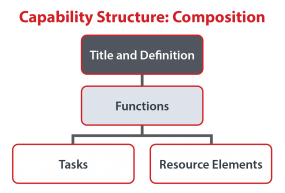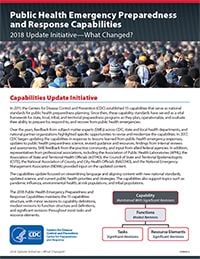Public Health Emergency Preparedness and Response Capabilities
In 2011, the Centers for Disease Control and Prevention (CDC) established 15 capabilities that serve as national standards for public health preparedness planning. Since then, these capability standards have served as a vital framework for state, local, tribal, and territorial preparedness programs as they plan, operationalize, and evaluate their ability to prepare for, respond to, and recover from public health emergencies.
Over the years, feedback from subject matter experts (SMEs) across CDC, state and local health departments, and national partner organizations highlighted specific opportunities to revise and modernize the capabilities. In 2017, CDC began updating the capabilities in response to lessons learned from public health emergency responses, updates to public health preparedness science, revised guidance and resources, findings from internal reviews and assessments, SME feedback from the practice community, and input from allied federal agencies. In addition, representatives from professional associations, including the Association of Public Health Laboratories (APHL), the Association of State and Territorial Health Officials (ASTHO), the Council of State and Territorial Epidemiologists (CSTE), the National Association of County and City Health Officials (NACCHO), and the National Emergency Management Association (NEMA) provided input on the updated content.
The capabilities update focused on streamlining language and aligning content with new national standards, updated science, and current public health priorities and strategies. The capabilities also support topics such as pandemic influenza, environmental health, at-risk populations, and tribal populations.

The 2018 Public Health Emergency Preparedness and Response Capabilities maintains the 15 capabilities structure, with minor revisions to capability definitions, modest revisions to function structure and definitions, and significant revisions throughout most tasks and resource elements.
Unlike the 2011 version, this 2018 update does not include programmatic performance measures. However, jurisdictional public health agencies are encouraged to use the updated content to foster their own evaluation strategies.
CDC incorporated revisions based on specific criteria that determined whether the suggested feedback
- Reflected the growth and evolution of public health preparedness and response;
- Supported the continued advancement of state and local preparedness programs;
- Drew upon the best available evidence and updated national resources;
- Avoided specific implementation guidance like what will be included in CDC’s Public Health Emergency Preparedness cooperative agreement requirements or evaluation criteria, such as performance measures; and
- Was applicable to diverse state, local, tribal, and territorial public health systems (avoiding unique topic areas and jurisdiction-specific approaches).
